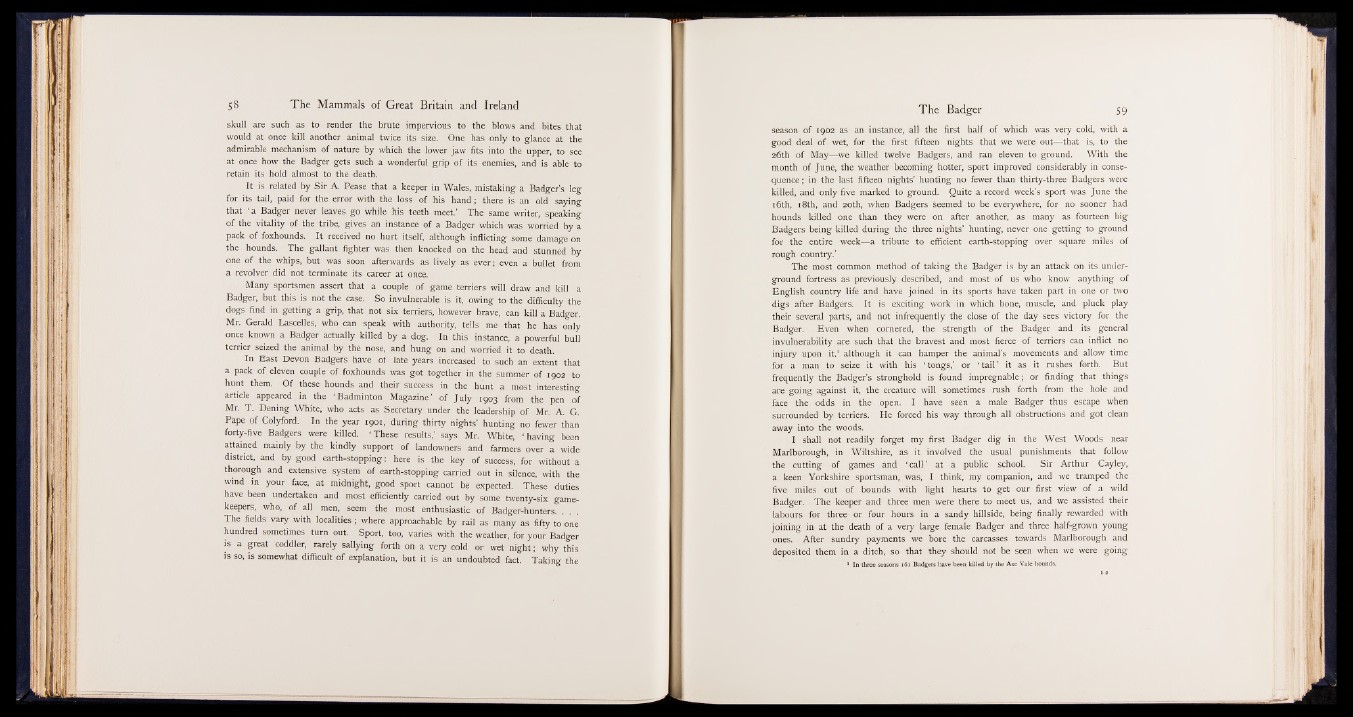
skull are such as to render the brute impervious to the blows and bites that
would at once kill another animal twice its size. One has only to glance at the
admirable mechanism of nature by which the lower jaw fits into the upper, to see
at once how the Badger gets such a wonderful grip of its enemies, and is able to
retain its hold almost to the death.
It is related by Sir A. Pease that a keeper in Wales, mistaking a Badger’s leg
for its tail, paid for the error with the loss of his hand; there is an old saying
that ‘ a Badger never leaves go while his teeth meet.’ The same writer, speaking
;/# the vitality of the triw j gives an instance of a Badger which was worried by a
pack of foxhounds. I( received no (hurt itself, although inflicting some damage on
the hounds,--IThe gallant fighter was then knocked on the head and stunned by
one of the whips, but was soon afterwards as livel_y_as ever; even a bullet from
a revolver did not terminate its career at once.
Many sportsmen assert that a couple of game terriers will draw and kill a
Badger, but this is not the case. So invulnerable is it, owing to the difficulty the
dogs find in getting a grip, that not six terriers, however bjlj||§ can kill a Badger.
Mr. Gerald Lascelles, who can speak with authority, tells me that he has only
once known a Badger actually killed by a dog. In this instance, a powerful b u lj
terrier seized the animal by the nose, and hung on and worried it to death.
In East Devon Badgers have of late years increased to such an extent that
a pack of eleven couple of foxhounds was gat-together in the summer of 1902 to
hunt them. Of these hounds and their success in the- hunt a most interesting
article appeared in the 'Badminton Magazine’ of Ju ly 1903 from the pen of
Mr. T. Dening White, who acts as Secretary undfe the leadership of Mr. A. G.
Pape of Colyford. In the year 1901, during thirty nights''hunting no fewer than
forty-five Badgers were killed. ‘ These results,’ S a p Mr. W h i l& f having been
attained mainly by the kindly support of landowners and farmers over a wide,
district, and by good earth-stopping: here is the key of success, for without a
thorough and extensive system of earth-stopping carried out in silence, with the
wind in your face, at midnight, good sport cannot be expected. These duties
have been undertaken and most efficiently carried out by some twenty-six game-
keepers, who, of all men, seem the most enthusiastic of Badger-hunters.
The fields vary with localities ; where approachable by rail as many as fifty to one
hundred sometimes turn out. Sport, too, varies with the weather, for your Badger
is a great coddler, rarely sallying forth on a very cold or wet night; why this
is somewhat difficult of explanation, but it is an undoubted fact. Taking the
season of 1902 as an instance, all the first half of which was very cold, with a
good deal of wet, for the first fifteen nights that we were out—that is, to the
26th of May—we killed twelve Badgers, and ran eleven to ground. With the
month of June, the weather becoming hotter, sport improved considerably in consequence
; in the last fifteen nights’ hunting no fewer than thirty-three Badgers were
killed, and only five marked to ground. Quite a record week’s sport was June the
16th, 1 8th, and 20th, when Badgers Seemed to be everywhere, for no sooner had
hounds killed one than they were on after another, as many as fourteen big
Badgers being killed during the three nights’ hunting, never one getting to ground
for the entire week—a tribute to efficient earth-stopping over square miles of
rough country.’
The most, common method of taking the Badger is by an attack on its underground
fortress as previously described, and most of us who know anything of
English country life and have joined in its sports have taken part in one or two
digs after Badgers. It is exciting work -in which bone, muscle, and pluck play
their several parts, and not infrequently the close of the day sees victory for the
Badger. Even when cornered, the strength of the Badger and its general
invulnerability are such that the bravest and most fierce of terriers can inflict no
injury upon it,1 although it can hamper the animal’s movements and allow time
for a man to seize it with his ‘ tongs,’ or ‘ tail’ it as it rushes forth. But
frequently the Badger’s stronghold is found impregnable; or finding that things
are going against it, the creature will sometimes rush forth from the hole and
face the odds in the open. I have seen a male Badger thus escape when
surrounded by terriers. He forced his way through all obstructions and got clean
away into the woods.
I shall not readily forget my first Badger dig in the West Woods near
Marlborough, in Wiltshire, as it involved the usual punishments that follow
the cutting of games and ‘ call ’ at a public school. Sir Arthur Cayley,
a keen Yorkshire sportsman, was, I think, my companion, and we tramped the
five miles out of bounds with light hearts to get our first view of a wild
Badger. The keeper and three men were there to meet us, and we assisted their
labours for three or four hours in a sandy hillside, being finally rewarded with
joining in at the death of a very large female Badger and three half-grown young
ones. After sundry payments we bore the carcasses towards Marlborough and
deposited them in a ditch, so that they should not be seen when we were going
1 In three seasons 161 Badgers have been killed by the Axe Vale hounds.